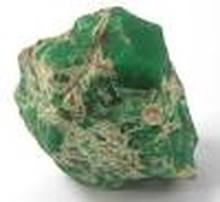Variscite is named after 'Variscia', the historical name of the Vogtland district in Saxony, Germany. It was first discovered and described in 1837, when it was found in massive fine-grained aggregate form; crystals are extremely rare. Variscite is an end-member of the isomorphic row of variscite-strengite series of minerals. Like the garnet and feldspar groups, variscite-strengite minerals have an identical crystalline structure, but exhibit slightly varying composition. Owing to variscite's unique mode of occurrence, it is often formed and associated with other phosphate minerals, resulting in interesting veining, splotches and other coloring habits. Although all variscite is valued by collectors, emerald-green variscite from Utah and the black spider-webbed variscite from Nevada are among the most desirable gemmy materials.
The finest localities for this mineral are in Utah. The most outstanding and best-known is Clay Canyon, near Fairfield, Utah County, where this mineral is found in veined nodules with other phosphates. We were lucky enough to acquire one ring so far.


 RSS Feed
RSS Feed


